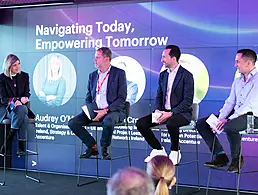Gender discrimination is an Irish employment law issue requiring urgent attention. William Fry partner Catherine O’Flynn explains how the clever use and application of AI can help.
Mandatory gender pay gap reporting is fast approaching in Ireland, with two separate pieces of legislation on the issue currently working their way through the legislative process.
On 26 June 2018, the cabinet approved the General Scheme of the Gender Pay Gap Information Bill. The proposed bill follows an earlier private members’ bill, the Irish Human Rights and Equality Commission (Gender Pay Gap Information) Bill 2017, which has already passed second stage in the Seanad. The Government bill will now take precedence over the earlier bill and we expect it to be published and debated later this year.
In our recent article, Bridging the Gap – The UK Experience, we examined the pitfalls in the similar UK system (which released its first results earlier this year) and discussed how that experience would provide the Irish legislature with food for thought on making Irish legislation watertight in enforceability, meeting deadlines and encouraging reporting.
1. Gender pay gap reporting
There is clear potential for AI to assist Irish employers to make our pay gap reporting accurate, thereby helping employers to better analyse data to resolve problems.
In the UK, companies were obliged to report and publish, amongst other data, their organisation’s mean and median gender pay gap in hourly pay. The median pay gap of those companies that reported was 9.7pc. However, the accuracy of the figures published have been called into question with the UK Office of National Statistics stating that the gap is higher at 18.4pc.
For UK companies that were obliged to report, instructions on how to gather, calculate and publish this information was provided online. There is certainly potential for AI to help employers in the gathering and calculation of the gender pay gap mean and median figures, and to make the process easier for employees and employers. AI can also help authorities with the collection and presentation of data.
2. Encouraging gender diversity
A central tenet of the Employment Equality Acts 1998 to 2015 is to prevent and remove discrimination in all its guises, including gender discrimination, from the workplace. These acts provide that employers may not discriminate on the gender ground in relation to access to employment, conditions of employment, promotion, re-grading etc.
In tackling gender discrimination, AI can be used to identify, learn from and prevent bias within organisations.
We have already examined the use of AI in recruitment through companies such as Textio, an ‘augmented writing’ platform that analyses job descriptions and suggests alternative wording to ensure gender balance and elimination of unconscious gender bias. Textio uses a ‘tone meter’ to help companies spot when certain words or phrases are imbalanced and notes that there are many thousands of combinations of words and phrases that can impact which gender applies for jobs. They explain that seemingly harmless words such as ‘exhaustive’ and ‘enforcement’ can create a gender imbalance in job descriptions.
The use of AI to analyse employee data – for example, to record and monitor employee remuneration and client satisfaction – may also be useful in preventing discrimination by removing unconscious bias from promotion and re-grading processes. Using AI to avoid unconscious bias affecting the decisions of employers is certainly useful for employment law purposes, although it is important to remember the caveat that AI technology still needs to be programmed by humans, and this part of the process leaves space for bias to be built into AI algorithms.
3. Maintaining engagement
It is widely acknowledged that family life has an impact on career engagement and progression. Maternity leave and parental duties are often cited as reasons why gender imbalance remains at higher management and executive levels.
Leading AI in the workplace commentator, Peter Cosgrove, notes that women are less likely to leave work if they are supported in their career development. An interesting use of AI, then, is as a means of providing this support and encouraging parents to remain engaged in the workplace, thus avoiding gender discrimination in promotion, access to roles and career progression for parents.
Take the use of collaborative workspaces such as Google Hangouts (a communications platform including video chat, instant messaging and online calls) and Microsoft Yammer (a private social network for employee collaboration) for example. As explored by Jeanne C Meister and Kevin J Mulcahy in The Future Workplace Experience, these platforms give employees outside the workplace the opportunity to engage with and contribute to work in a meaningful way.
AI can be used in these circumstances to undertake tasks that usually require employees to be in the workplace. For example, The Irish Times recently reported on a Swiss bank that has ‘cloned’ its regional chief investment officer so that he can give briefs to clients and staff in a digital format. The ‘clone’ appears on a screen and is programmed to answer questions and give advice on specific areas.
While this is in an early prototype stage, it provides an interesting insight into the solutions AI can present to typical employment issues. Solutions such as this can support gender equality by assisting parents in maintaining engagement with their work while outside the workplace.
New tools in the gender discrimination fight
While AI does not present a perfect solution to all gender discrimination issues, it certainly presents interesting solutions to problems encountered by employers and a new means of tackling gender diversity issues.
Using AI in gender pay gap reporting, to avoid unconscious bias and to improve links to work for those not in the workplace will assist employers in avoiding common occurrences of gender discrimination.
In times where employers continue to explore the exciting world of AI in the workplace, we continue to explore its employment law possibilities and effects.
Catherine O’Flynn is a partner at William Fry and head of the firm’s Employment & Benefits department. She advises on all contentious and non-contentious employment matters with a particular expertise in equality issues.
A version of the article originally appeared on the William Fry blog.




